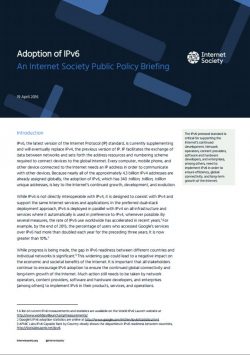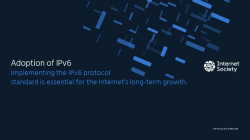Introduction
IPv6, the latest version of the Internet Protocol (IP) standard, is currently supplementing and will eventually replace IPv4, the previous version of IP. IP facilitates the exchange of data between networks and sets forth the address resources and numbering scheme required to connect devices to the global Internet. Every computer, mobile phone, and other device connected to the Internet needs an IP address in order to communicate with other devices. Because nearly all of the approximately 4.3 billion IPv4 addresses are already assigned globally, the adoption of IPv6, which has 340 trillion, trillion, trillion unique addresses, is key to the Internet’s continued growth, development, and evolution.
While IPv6 is not directly interoperable with IPv4, it is designed to coexist with IPv4 and support the same Internet services and applications. In the preferred dual-stack deployment approach, IPv6 is deployed in parallel with IPv4 on all infrastructure and services where it automatically is used in preference to IPv4, whenever possible. By several measures, the rate of IPv6 use worldwide has accelerated in recent years. [1] For example, by the end of 2015, the percentage of users who accessed Google’s services over IPv6 had more than doubled each year for the preceding three years. It is now greater than 10%. [2]
While progress is being made, the gap in IPv6 readiness between different countries and individual networks is significant. [3] This widening gap could lead to a negative impact on the economic and societal benefits of the Internet. It is important that all stakeholders continue to encourage IPv6 adoption to ensure the continued global connectivity and long-term growth of the Internet. Much action still needs to be taken by network operators, content providers, software and hardware developers, and enterprises (among others) to implement IPv6 in their products, services, and operations.
Many organizations have taken initiatives to globally promote the implementation of IPv6. The Regional Internet Registries (RIRs) [4], which participate in assigning blocks of IP addresses to Internet Service Providers (ISPs) and other networks, champion IPv6 awareness, policy initiatives, and development and technical training to facilitate IPv6 adoption. In addition, initiatives like 6NET and 6DEPLOY have advanced deployment through research and testing activities in developed and developing countries. [5]
The Internet Society has encouraged IPv6 adoption by serving as a resource for IPv6 information and by supporting organized initiatives like World IPv6 Day in 2011 and World IPv6 Launch in 2012. These initiatives brought together deployment efforts and industry players, who worked collaboratively towards permanently deploying IPv6 on the global Internet. By acting together, ISPs, Web companies, and equipment vendors have considerably increased IPv6 use. For example, today four of the top visited five websites in the world are accessible via IPv6.
IPv6 adoption in the marketplace has also been spurred by the deployment of a number of technologies. Current versions of major computer operating systems, including those on mobile devices, have built-in support for IPv6; more-recent networking equipment, such as switches, routers, and cable modems, include support for IPv6.
Key Considerations
IPv6 adoption is necessary if we plan to scale-up Internet infrastructure and connect more users and devices to the Internet. Key considerations driving the need and demand for IPv6 adoption include:
- Direct addressability. A growing number of devices connected to the Internet, including those envisioned by the Internet of Things (IoT), require globally unique IP addresses to operate properly or realize their full potential. Devices that are intended to be directly addressable across the Internet require true end-to-end connectivity provided by unique IP addresses; they will not be able to rely on using IPv4. Furthermore, the workaround technologies used to extend IPv4 addressing are not always suitable.
- Cost and complexity. Exclusively using IPv6 decreases the cost and complexity of continuing to support IPv4 in operating networks. Using IPv6 can reduce the resources required to continue to support legacy IPv4 devices, which can also simplify network management and troubleshooting in some cases. Native IPv6 traffic can be expected to perform better and more reliably than IPv4 traffic using transitional techniques. It is anticipated that the cost of using IPv4 will continue to increase as compared to IPv6.”
- Default IPv6 support. Enabling IPv6 by default will eliminate the need for action by users and thereby increase adoption. In this way, the correct initial configuration of computers and mobile devices, as well as software, such as Web browsers and operating systems, is a key stimulus for the adoption of IPv6.
- Existing IPv4 devices. Many of the billions of devices already connected to the Internet are designed to use only IPv4 addresses and won’t automatically operate on IPv6 networks. It is not feasible to require that all Internet traffic switch to the IPv6 standard if it would leave IPv4 devices unable to communicate. To address this problem, workaround techniques have been developed to simultaneously enable both IPv4 devices and IPv6 devices to send and receive data across the Internet. These techniques include tunneling and address translation protocols. [6] These protocols enable IPv4 devices to continue to operate, but they require extra configuration, consume resources, and can be the cause of reliability issues. [7]
- Economic growth and innovation. Internet address resources are essential to the evolution and functioning of the Internet and our flourishing digital economies. National infrastructures that use IPv6 are better equipped to support economic opportunity and innovation in areas such as IoT, smart grids, smart infrastructure, and smart buildings. As all IPv4 addresses are allocated globally, the cost of obtaining IPv4 addresses is expected to become much more expensive as a limited number of address blocks are traded.
Challenges
The challenges to greater implementation of IPv6 are centered on informing the Internet industry in its broadest sense of (1) the ever-growing need and importance of migrating to the IPv6 standard, and (2) continuing to grow the existing base of IPv6 users.
Making product and operational modifications. Network operators, content providers, software and hardware developers, among others, often need to make changes to their systems and services in order to implement IPv6. This has become easier with an increase of technology supporting IPv6, support materials, implementation tools, and skills in the marketplace. However, implementing IPv6 does require effort, skill, and resources. Some companies have chosen to delay this investment or are waiting until their peers, competitors, and service providers also adopt IPv6.
Expanding the base of IPv6 users. Growing the number of IPv6 users will further accelerate the overall pace of IPv6 adoption. With increased adoption, the overall capabilities of the network will improve as the incremental costs decrease. This makes it more technically and economically attractive for additional users to adopt IPv6. In other words, the network effect creates positive feedback as the gain to everyone grows with the addition of the new IPv6 deployments to the Internet. For this reason, growing the number of IPv6 users is especially key in markets where adoption is lagging.
Perceived lack of need. An impediment to IPv6 adoption is the perception that IPv6 does not have a specific, compelling need, or a “killer application” that will motivate network operators and product developers to adopt it. The success of temporary workarounds such as Network Address Translation (NAT) has masked the importance and urgency of adopting IPv6. However, as available IPv4 addresses become scarcer, laws of supply and demand suggest that the costs of IPv4 addresses and IPv4 networks will increase to the point that they become greater than the costs associated with deploying IPv6.
The convergence of these factors tends to foster an overall misperception that there is no compelling need for IPv6 adoption. But these are short-term, temporary factors. The long-term value of IPv6 in reducing complexity and enabling innovation will emerge as a driving force in IPv6 adoption. By adopting IPv6 now, network operators, other industry players, and users will position themselves to take advantage of its long-term benefits and will avoid, as much as possible, the additional costs of continuing to support IPv4 connectivity services.
Guiding Principles
Given the depletion of IPv4 addresses, increased public-sector awareness of the consequences and the importance of IPv6 take-up are essential. Governments can take the following steps to encourage IPv6 deployment:
Understanding IPv6 and stakeholder engagement. All governments should thoroughly understand the issue; they should be responsive to and engage with relevant stakeholders and the Internet community. In addition to engaging national industry players, governments should seek to engage their respective regional Internet registry (RIR) to find IPv6 information and resources on IPv6 deployment and to participate in related discussions. In addition, organizations and forums, such as the Internet Society, global and regional Internet Governance Forums, and network operators groups, can be tapped to provide learning opportunities about IPv6.
Leading by example. Governments can provide leadership by making IPv6 implementation a priority within the government itself. Many governments have put specific government agencies or interagency working groups in charge of implementing IPv6 in government IT systems. Some also have established government IPv6 implementation schedules and requirements for agencies to report their implementation progress.
Communicating IPv6 as a national priority. Governments can play a leadership role by communicating support for IPv6 implementation and discussing its importance with both industry stakeholders and government IT professionals. By declaring that IPv6 will play an important part in the future of their societies and economies, governments can stimulate IPv6 adoption by key stakeholders. Some governments have also set up multistakeholder IPv6 advisory groups and task forces, in some cases, tasking them with producing or contributing to national action plans. [8]
Encouraging industry participation in capacity-building opportunities. To increase their knowledge of IPv6 deployment techniques, both commercial and public-sector network operators should be encouraged to participate in training and other capacity-building opportunities.
In addition, the Internet Governance Forum Best Practices guide, Creating an Enabling Environment for IPv6 Adoption [9], also sets forth useful guidance and background for governments and other stakeholders wishing to learn more and take action on IPv6 deployment.
Additional Resources
The Internet Society has published a number of papers and additional content related to this issue. These are available for free access on the Internet Society website.
- Internet Society Deploy360 Programme, IPv6 Resource Web page, http://www.internetsociety.org/deploy360/ipv6/.
- Internet Society IPv6 Technology Web page, http://www.internetsociety.org/what-we-do/internet-technology-matters/ipv6.
- World IPv6 Launch Website, http://www.worldipv6launch.org.
- Internet Society Online Tutorial: “Introduction to IPv6”, https://www.internetsociety.org/tutorials/exploring-ipv6 (English) and http://www.internetsociety.org/es/tutoriales/explorando-ipv6 (Spanish).
Notes
[1] A list of current IPv6 measurements and statistics are available on the World IPv6 Launch website at http://www.worldipv6launch.org/measurements/.
[2] Google’s IPv6 adoption statistics are online at http://www.google.com/intl/en/ipv6/statistics.html.
[3] APNIC Labs IPv6 Capable Rate by Country clearly shows the disparities in IPv6 readiness between countries, http://stats.labs.apnic.net/ipv6.
[4] For information about the Regional Internet Registries and a link to their individual websites, see https://www.nro.net/.
[5] 6NET information can be found at https:// www.6net.org/, 6DEPLOY-2 information can be found at http://www.6deploy.eu.
[6] Information on these technologies can be found in the IETF RFC 6180, “Guidelines for Using IPv6 Transition Mechanisms during IPv6 Deployment”, http://tools.ietf.org/html/rfc6180.
[7] A more detailed technical discussion of supporting IPv4 devices can be found in the IETF RFC 6269, “Issues with IP Address Sharing”, http://tools.ietf.org/html/rfc6269.
[8] See the Internet Society’s resource Web page for regional information about IPv6, http://www.internetsociety.org/deploy360/ipv6/.
[9] The Internet Governance Forum report, Best Practices Forum on Creating an Enabling Environment for IPv6 Adoption, sets forth useful guidance and background in this area. See http://www.intgovforum.org/cms/documents/best-practice-forums/creating-an-enabling-environment-for-the-development-of-local-content/581-igf2015-bpfipv6-finalpdf/file.

